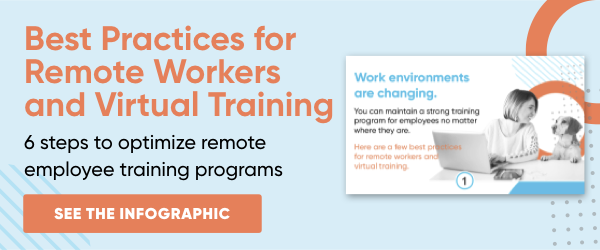For companies across all sectors, the COVID-19 pandemic has changed everything, from the way they conduct business to the health of their bottom line. One of the biggest ways COVID-19 has disrupted the way organizations operate is by necessitating that as many employees as possible work from home.
“In response to the uncertainties presented by Covid-19, many companies and universities have asked their employees to work remotely,” according to Harvard Business Review.1 “While close to a quarter of the U.S. workforce already works from home at least part of the time, the new policies leave many employees — and their managers — working out of the office and separated from each other for the first time.”
One of the keys to successfully managing a dispersed workforce and promoting productivity is to continue offering employee training via online learning, or eLearning. Employee training promotes job satisfaction, employee motivation, increased efficiency in processes, and better innovation in strategies and products, per Management Help.2 Online employee training can also boost engagement, morale, and a sense of normalcy for workers, all of which are needed during this time of uncertainty and stress.

4 Tips for Training Remote Employees
Successfully Using eLearning
Here are a few ways your company can ensure online training for remote employees is as impactful as possible:
Related Reading: How eLearning Tools Enable Remote Training During the COVID19 Pandemic
1. Ask learners what they need before creating content
It’s important to check in with your learners before you create training content for them. After all, they are the ones that have to participate in training, and they often have a sense of what type of training content is most beneficial for them. By asking learners what type of training they feel they need, how interactive they want it to be, how they want it delivered to them, and what training mediums they prefer (audio, video, etc.), company leaders can avoid spending time and money creating irrelevant training that doesn’t deliver the greatest ROI for the organization. Surveys are a helpful tool to gather this information with.
2. Implement learner engagement strategies that get results
Engagement with training cannot be overemphasized for remote learners. When employees aren’t invested in training, knowledge retention suffers, as does participation in training. Learner engagement may be a struggle for remote employees as they don’t have the same positive social peer pressure to complete training as their on-location coworkers do. The good news is that there are many ways to engage learners. One is to get them more involved with training by having them answer poll questions and/or typing any questions they may have about an online course into a chat room forum. This not only gets them interacting at a deeper level with training, but it also promotes knowledge sharing, which is a contributor to engagement, as other learners can answer the questions posed in the chat room or forum and share their expertise.
Related Reading: 3 Tips to Make Corporate eLearning Courses More Engaging
3. Incentivize training with rewards that appeal to remote workers
There is perhaps no better way to make online employee training more effective than by incentivizing training. Employees tend to respond very positively to incentives, but remote workers sometimes go without these opportunities. Make your remote employees feel valued by offering specific-to-them incentives for completing training, such as a meal or food delivery service gift, a new app, a laptop upgrade, or a piece of home office equipment, such as a printer.
4. Use a variety of types of content to keep training interesting
Online training can become monotonous quickly when just one or two modes of training are used. For example, some online learning courses consist of plain text and simple graphics. This may not be sufficient to engage learners and drive knowledge retention. To take remote learning to the next level, use several different types of training in your eLearning courses, especially videos, webinars, and video conferencing to maintain face-to-face check-ins. Launching an online learning platform with features that facilitate these types of training, such as social learning tools, can be helpful to organizations that want to up the engagement factor and effectiveness of employee training for remote workers.
Deploy eLearning for Your Remote Employees Quickly
Ready to launch remote eLearning rapidly? Our Quick Start program helps organizations set up and fully deploy the TOPYX LMS learning solution in a matter of days. With features and pre-built content to support remote workers and develop skills, it's a great time to invest in your employees, contractors, and partners.
References:
[1] https://hbr.org/2020/03/a-guide-to-managing-your-newly-remote-workers
[2] https://managementhelp.org/training/basics/reasons-for-training.htm








